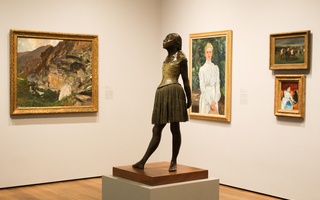“Colors are only symbols. Reality is to be found in luminance alone.” In saying this, Pablo Picasso expressed one of the messages conveyed by the Harvard Art Museums last Wednesday. “Your Brain on Art: How Does Light Influence Our Creation and Perception of Images?,” an event that attracted art and science admirers from around the Cambridge area, was an effort by the Harvard Art Museums, Harvard Museums of Science and Culture, and the Harvard Brain Science Initiative not only to explore the work of two very different professors, but also to attempt to unite both fields with a common goal or inspiration. At the event, Dr. Margaret S. Livingstone, a professor of neurobiology at Harvard Medical School and author of “Vision and Art: The Biology of Seeing,” and Sharon C. Harper, a visual and environmental studies professor, shared their perspectives on how art and science can be used in conjunction to advance each individual field.
As a medical researcher, Livingstone’s main goal is to explore the neurological processes that lead to facial recognition and learning as humans grow and change throughout their lives. One of the modes through which she explores the complex mechanisms involved in visual information processing in human beings is art. “Artists have been way ahead of us in figuring these things out,” she said at the event. According to Livingstone, long before neurobiologists understood that the human brain can locate contrasting elements in an image very quickly, Claude Monet had already used darker colors to focus attention on a sun in a painting.
Livingstone’s portion of the talk began by exploring the colors, luminance, and motions that the brain perceives in artistic movements such as Impressionism, Cubism, and Pointillism and eventually culminated in the analysis of one of art and science’s greatest mysteries: why the “Mona Lisa” seems to have a different smile depending on how one views the painting. “Don’t you find that she’s smiling more when you’re looking at her eyes than when you’re looking at her mouth?” Livingstone asked the audience. By observing differences in human vision depending on the angle at which an object is seen, she found a solution that came down to a simple science: Looking at Mona Lisa’s eyes makes her smile look wider and happier than looking directly at her mouth does because receptors in the eye have varied responses to the different angles in the painting.
To complement Livingstone’s presentation, which showed how art can inform science, Harper took the stage to explain to the audience the effect of science upon art. Harper, a renowned photographer whose images incorporate various scientific phenomena, explained the inspiration behind her art using “Moon Studies and Star Scratches, No. 2,” a photo series from 2003, as an example. “My approach to art-making is experimental,” she said. For example, by making use of the effect of light upon the moon as it passes through its cycle, Harper incorporated the scientific into a decidedly humanistic artwork. But by organizing the photographs in a way that was aesthetically pleasing rather than chronological, she avoided the pure technicality of a moon-phase chart. Through the use of her own photographs to show how light changes throughout the day and year, Harper demonstrated to the audience that science forms an integral part of her artistic endeavor.
Cutting across the lines separating art and science, this presentation brought together two disparate fields to explore why human beings perceive and appreciate art in the way they do. But the talk also raised deeper questions like Harper’s about the nature of humanity’s place in the world: “How are we connected to things we cannot reach, touch, or understand?”
Read more in Arts
Artist Spotlight: Oliver AldortRecommended Articles
-
Suit for Damages Continues After Reappearance of Missing PaintingBULLETIN Harry Lacey, a Boston interior the Rubens' painting, "Descent from the Rubens' painting, "Descent from the Cross," to the
-
Art Lectures.Four courses of free public evening lectures on art are to be given this winter, the aim being to add
-
Mr. Blashfield's Lecture.A large audience heard Mr. Blashfield lecture last evening in the Jefferson Physical Laboratory on "The City of the Renaissance,
-
Communication(The CRIMSON invites all men in the University to submit signed communications of timely interest. It assumes no responsibility, however,
-
 Beauty and the Brain: The Emerging Field of Neuroaesthetics
Beauty and the Brain: The Emerging Field of Neuroaesthetics













